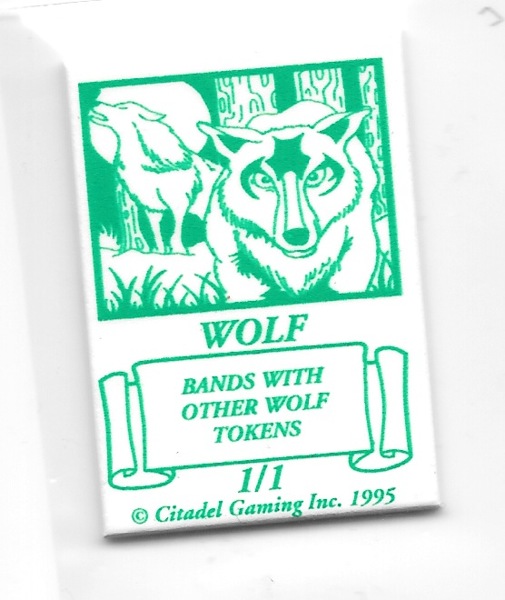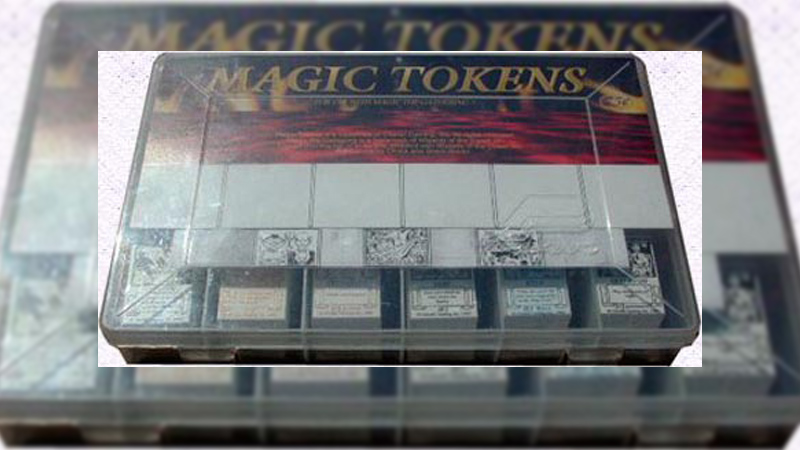Magic: The Gathering's first "official" tokens didn't come from Wizards of the Coast.
Ever since Magic: The Gathering began in the 1993, the use of tokens has been important thanks to cards like The Hive and whatnot. The issue, though, is that Wizards of the Coast never made any official ones, leaving players to instead use glass beads, coins, dice, scraps of paper, and whatever else they could find. After all, when more creatures or whatever are created, you need to put something down.
For the first two years it was all still pretty much a "use whatever you want" world. In late 1994, however, the game's fifth expansion, Fallen Empires, had a lot of cards that needed tokens and counters. This led to two things happening: (A) The next issue of The Duelist magazine actually had to include a huge cardboard inset of printed off token cards, as did the two-issue Fallen Empires comic book series; and (B) one company actually made the first printed tokens made especially for Magic: The Gathering (and this was way before WotC itself made its own officially printed token cards).
 Sold only in Oregon, these first tokens came out in 1995. Created by the Eugene, Oregon, company Citadel Gaming, all of the creatures were printed out on plastic and were meant to be sold for only 25 cents. Somehow they managed to get around the copyright and called these things "Magic Tokens" (though probably for the same reason that WotC couldn't just trademark "Magic," forcing them to add "The Gathering" to the title).
Sold only in Oregon, these first tokens came out in 1995. Created by the Eugene, Oregon, company Citadel Gaming, all of the creatures were printed out on plastic and were meant to be sold for only 25 cents. Somehow they managed to get around the copyright and called these things "Magic Tokens" (though probably for the same reason that WotC couldn't just trademark "Magic," forcing them to add "The Gathering" to the title).
Confused as to why you never heard of them before today? Well, it turns out that they kinda sucked. The first batch that came out in July of 1995 had a black dye problem with the coloration. It turns out that the dye bled down, meaning that any surface that the token touched now had a pretty good chance of getting smudged. Also, it was later learned that their display manufacturer didn't know how to properly press the type of plastic being used, which was known as SINTRA. No one had told them that they had to heat the presses before molding out the tokens to improve quality and to get rid of any issues. But, it was too late. Once the second run came out, the first one was brought immediately to a dump somewhere in central Oregon.
Stores were happy to have the second run of tokens....that is until they realized they couldn't be individually sold very easily. They all came in packs of 25, meaning that unless the store owner broke them up, that 25 cent purchase really cost you more than $6.00, plus tax.
By September a large third run of about 150,000 tokens came out, adding new colors and finally seeming like they hit their stride. They came in boxes where individual ones could be sold, and it all came out looking like a nifty way to sell some off-brand non-licensed tokens for Magic: The Gathering. Or, well, it would have if everything didn't go to hell.
In 1996, Citadel Gaming (as well as the display manufacturer, Mobius) went out of business. The early losses had taken their toll and had severely drained the resources of the company.
Today, while specialized tokens and such do exist, most players still use those glass beads, dice, or (now) the official Magic: The Gathering creature token cards to use as tokens during gameplay.
While Citadel's Magic Tokens were a good idea, sometimes the simpler ideas stick around in the end.









